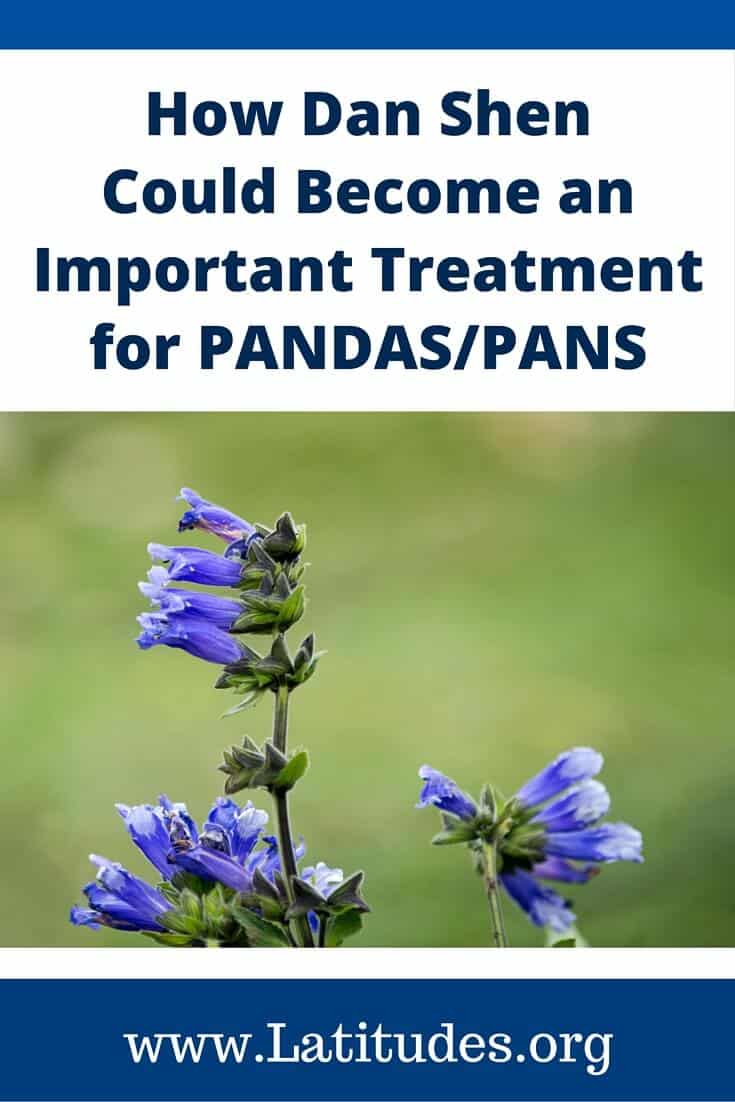How Dan Shen Could Become an Important Treatment for PANDAS/PANS
ACN Latitudes Team
When learning about PANDAS/PANS, parents struggle to understand what’s happening to their child. They also struggle to find supportive doctors and effective treatments. A medication now in FDA Phase III trials for diabetic eye disease may offer new options for halting the autoimmune response that causes so much turmoil in this disease. This drug is not yet available in the U.S. but is derived from Dan Shen, an herb used in Traditional Chinese Medicine. Dan Shen (Radix Salvia Miltiorrhizae, also known as Red Sage), contains Tanshinone, which may prevent migration of immune cells across the blood brain barrier.
In PANDAS/PANS, it’s presumed that an infection triggers an abnormal immune response that leads to both brain inflammation and extreme changes in a child’s behaviors and abilities. After years of debate over a lack of “proof” of this theory, researchers have finally outlined the cascade of events that leads to the development of PANDAS and then PANS.
In a study published in the December 2015 online edition of the Journal of Clinical Investigation, researchers showed how Th17 immune cells triggered by recurrent Strep A infections cross the blood brain barrier (BBB), causing inflammation that may lead to autoimmune neuropsychiatric disorders in children. The authors show that:
An initial upper respiratory GAS infection would induce the production of Abs that mimic and cross-react with CNS epitopes as well as prime a Th17 cellular response that may or may not be autoreactive. Subsequent GAS infections would further amplify both autoantibody levels and, in some individuals, increase the Th17 effector memory pool beyond a threshold required for cell migration from the mucosal epithelium into the OB (olfactory bulb) along the olfactory nerve. Within the brain, the inflammatory response induced by IL-17A and/or activated microglia and macrophages then disrupts the BBB, which permits autoreactive Abs to leak into the OB and other regions of the brain. The connection between GAS and behavioral exacerbations in PANDAS patients is confounded by occasional association with other non-streptococcal infections and the occasional failure to find evidence of GAS infections. (Dileepan et al, 2015, p.313)*
The authors also note that:
Several other bacterial or viral pathogens, including influenza virus, mycoplasma, and Staphylococcus aureus, induce robust Th17 responses and therefore could also play a role in the exacerbation of behavioral symptoms in children with PANDAS if autoantibody levels are primed by previous GAS infections. (Dileepan et al, 2015, p. 313)
*Editor’s note for text above: BBB=Blood brain barrier; GAS = Group A Streptococcus; Abs = antibodies; CNS = Central Nervous System
Translation: The body produces immune cells (T cells) against a streptococcus infection. Those T cells then migrate across the sinus tissues and into the olfactory bulb, where they cross the BBB. Once on the brain side of the BBB, glial cells (immune cells found on the brain side of the BBB) may be called into action to attack the perceived T Cell invaders, creating destructive inflammation and miscommunication between neurons. The study goes on to explain that once the body has gotten into the habit of making these migratory T cells from previous strep infections, other infections that provoke the production of similar T cells can trigger a similar Pans response.
To alleviate a PANDAS/PANS episode, it seems there are at least two critical steps to healing. The most important is to eradicate the infection, after which the immune system should stop producing antibodies, inflammation should subside and the BBB should close. Unfortunately, even after an active infection is cleared, antigen-specific T cells can persist for several months. Complicating things even more, some PANS-triggering infections can be chronic (e.g. Lyme, Mycoplasma, Staphylococcus) (Dileepan et al, p. 306), meaning that a patient (and the family) may battle excruciatingly long PANS episodes if the BBB remains open.
So while the quest to correctly identify and treat an infection is critical, it isn’t always the only step that’s needed. You not only need to catch the horse, you also need to close the barn door. Parents and doctors have long struggled to take that second step of helping the body close the tight junctures of the BBB, shielding the central nervous system from the PANS autoimmune response.
Dan Shen may help close that barn door. In the January 2016 edition of the European Journal of Pharmacology, researchers demonstrated that one of the active components of Dan Shen, Tanshinone IIA:
. . . suppresses disruption of the blood-brain barrier and reduces expression of adhesion molecules and chemokines in experimental autoimmune encephalomyelitis. Tanshinone IIA (TSIIA), one of the major bioactive components of the traditional Chinese herb Salvia miltiorrhiza, has been reported to have both anti-inflammatory and immunoregulatory effects. The effect of treatment with TSIIA in multiple sclerosis, an autoimmune inflammatory neurodegenerative disease, however, remains poorly understood.
In the present study, experimental autoimmune encephalomyelitis (EAE), a classical experimental model of multiple sclerosis was used to investigate the therapeutic effect of TSIIA. TSIIA attenuated motor dysfunction and improved inflammation and demyelination associated with EAE in a dose-dependent manner. TSIIA also significantly reduced the levels of glial fibrillary acidic protein (GFAP) and ionized calcium-binding adapter molecule-1 (Iba-1), and protected the integrity of the blood-brain barrier (BBB) by increasing the expression of critical endothelial tight junction (TJ) proteins.
TSIIA also inhibited the expression of some adhesion molecules and chemokines, which are considered to be critical for adhesion of immune cells and migration across the BBB. TSIIA was thus shown to be effective in the treatment of EAE through preventing the infiltration of immune cells into the CNS, strengthening the integrity of the BBB and decreasing the numbers of adhesion molecules and chemokines. (Yang, 2016)*
Translation: Tanshinone IIA, a major component of Dan Shen, seems to tighten the BBB and calm glial cells – the cells triggering the Pans inflammation on the brain side of the BBB. It also seems to make it harder for T cells to cling to and migrate along the sinus tissues.
This is exactly what researchers describe as the underlying problem faced by PANDAS/PANS children. Dan Shen may offer a way to literally halt the madness caused by PANS. This would be a game changer.
Additional benefits of Dan Shen
 Some additional benefits of Dan Shen include its antibacterial effects against Staphylococcus and MRSA (methicillin-resistant staphylococcus aureus) (Jeong-Dan Cha, 2014). Dan Shen also decreases white blood cell rouleaux (aggregation) and inhibits superoxide. It also scavenges Reactive Oxygen Species (ROS), providing an anti-oxidant benefit (Chin, 2011) and may act as an anti-inflammatory by inhibiting MMP-9 proteins and stress-reactive proteins (SAP) (Liu, 2010).
Some additional benefits of Dan Shen include its antibacterial effects against Staphylococcus and MRSA (methicillin-resistant staphylococcus aureus) (Jeong-Dan Cha, 2014). Dan Shen also decreases white blood cell rouleaux (aggregation) and inhibits superoxide. It also scavenges Reactive Oxygen Species (ROS), providing an anti-oxidant benefit (Chin, 2011) and may act as an anti-inflammatory by inhibiting MMP-9 proteins and stress-reactive proteins (SAP) (Liu, 2010).
With all things, it’s about balance and realistic expectations. Dan Shen is traditionally used to treat coronary heart diseases, ischemic stroke, diabetes and chronic renal failure. It is a blood thinner and should not be used for patients taking Warfarin and may interfere with digoxin. While neither of these drugs are likely to be used for children, non-steroidal anti-inflammatory drugs (NSAIDs) like Motrin also have a blood-thinning effect and used in conjunction with Dan Shen, there may be a higher risk of bruising or bleeding (anthocyanins found in bilberry and quercetin can strengthen capillaries and may alleviate a potential bruising side effect).
There are a few other qualities of Dan Shen to keep in mind for PANS children. Over time, Dan Shen can raise acetylcholine levels. This could be helpful for a PANS child who struggles with ADD or ADHD symptoms. But past a certain threshold, acetylcholine can trigger fight or flight adrenaline symptoms. Dan Shen may also inhibit MAO-B degradation of dopamine, although it is not the primary gene that regulates this neurotransmitter. Dan Shen may also raise estrogen levels, presumably in a dose-dependent manner. If symptoms related to increased acetylcholine (e.g. anger, aggression, flight behaviors) or increased dopamine (e.g. tics) worsen while taking Dan Shen, a lower dose and/or increased time between doses may be advisable. This is a case where a little can be a good thing but more is not always better.
For these reasons, Dan Shen is traditionally used for no more than a month at a time. It holds promise to be an effective treatment with many benefits but the potential for side effects and need for monitoring may increase if used longer term.
Known Benefits:
- Antibacterial properties against MRSA and Staphylococcus aureus
- Decreases white blood cell rouleaux (aggregation)
- Inhibits superoxide
- Scavenges reactive oxygen species (ROS)
- Inhibits MMP-9
- Inhibits stress-reactive protein (SAP)
- Reduces IgE
- Helps with insomnia
- Changes copper metabolism – binds copper and retards growth of fibrin
- Reduces cholesterol and triglycerides
Things to Keep in Mind about Dan Shen
- Inhibits MAO-B
- Can raise acetylcholine
- Thins blood – use NSAIDs with caution
- May raise estrogen levels
- May stimulate thyroid
- Slows nerve impulses in the heart, slowing pulse but increasing volume per beat
- Side effects can include itching, nausea, decreased appetite
Dosing
Dosage for adults being treated for cardiovascular diseases can range from 5-15g. Doses of 100mg/kg as a bolus injection can be used with children. Herbalist Stephen Buhner discusses Dan Shen in his book “Natural Treatments for Lyme Coinfections: Anaplasma, Babesia, and Ehrlichia” (2015) and suggests ½ tsp 3x daily, for a 150 lb. adult. But he also says that for specific symptoms this dose can be increased to 1 tsp 3x/day or for cases of extreme pain, an adult could use up to 1 tbsp. every 15 minutes, slowly decreasing the dosage as the pain subsides.
As with most tinctures, it’s a good idea to start with 1-2 drops, 2-3 times per day and increase the dose slowly as tolerated (up to 15 drops/dose for a 75 lb. child using a 1:5 tincture). Buhner stresses in all his books that dosing recommendations are general guidelines and should always be adjusted based on individual responses. Also bear in mind that herbal tinctures are not standardized and the potency of an herb may vary between harvests and between suppliers. This means dosing may need to be tweaked not only as a patient proceeds in treatment but also when a new bottle of a tincture is started.
In general, herbs have strong tastes and aromas. They are hard to disguise in foods or drinks. For children who can swallow pills, consider putting the dose into a gel cap (available at health stores and online) and swallowing the pill quickly before the liquid dissolves the capsule (within 1-2 minutes).
Availability
Buhner lists several respected herbal suppliers in his books. Among them are:
Other suppliers are also listed on Buhner’s website www.buhnerhealinglyme.com
NOTE: *Don’t confuse Red Sage with Red Root – a different herb entirely. Always confirm that the herb is from the species Radix Salvia Miltiorrhizae.
As noted earlier, a patented formula containing Dan Shen cleared Phase II trials with the FDA in 2010. While currently available in other parts of the world, this Dan Shen formula entered Phase III trials and if successful, could eventually be available as a prescription in the U.S. Until then, herbal tinctures may offer relief to families currently struggling for affordable and effective treatment options.
One of the arguments PANDAS naysayers have used to dismiss PANDAS is that many children contract streptococcus infections without developing the neuropsychiatric symptoms associated with PANDAS. Current research indicates that the event that creates a PANDAS child is the migration of T cells into the olfactory bulb and across the BBB. Dan Shen seems to have properties that prevent T cell migration and tighten the junctures of the BBB. Dan Shen holds the potential to prevent or halt a PANDAS response in susceptible children while the triggering infection is treated. The implications for a PANDAS child could be literally life-changing.
References
- Dileepan, T., Smith, E.D., Knowland, D., Hsu, M., Platt, M., Bittner-Eddy, P., Cohen, B., Southern, P., Latimer, E., Harley, E., Agalliu, D, and Cleary. P., Group A Streptococcus intranasal infection promotes CNS infiltration by streptococcal-specific Th17 cells, The Journal of Clinical Investigation, December 14, 2015 Pages 303-317 http://www.jci.org/articles/view/80792
- Xue Yang , Jun Yan, Juan Feng, Treatment with tanshinone IIA suppresses disruption of the blood-brain barrier and reduces expression of adhesion molecules and chemokines in experimental autoimmune encephalomyelitis, European Journal of Pharmacology, Volume 771, 15 Jan 2016, Pgs 18–28 http://www.sciencedirect.com/science/article/pii/S0014299915304088
- Jeong-Dan Cha, Jeong-Ho Lee, et al, Synergistic Effect between Cryptotanshinone and Antibiotics against Clinic Methicillin and Vancomycin-Resistant Staphylococcus aureus Evidience Based Complementary and Alternative Medicine, published online 2014 Mar 24 http://www.ncbi.nlm.nih.gov/pmc/articles/PMC3982256/
- Chin A, Yang Y, Chai L, Wong RW, Rabie AB (July 2011). “Effects of medicinal herb salvia miltiorrhiza on osteoblastic cells in vitro”. J. Orthop. Res. 29 (7): 1059–63. http://onlinelibrary.wiley.com/doi/10.1002/jor.21376/full
CS1 maint: Multiple names: authors list (link) - Liu C, Min L-Q, Ji Z-S; et al. Protective effects of salvia miltiorrhizae on oxidative stress in rats with focal cerebral ischemia. Chin J Clin Rehabil (in Chinese) 10 (3): 37–9. CS1 maint: Multiple names: authors list (link)Chin Med. 2010; 5: 22. Published online 2010 Jun 21. doi: 10.1186/1749-8546-5-22 http://www.ncbi.nlm.nih.gov/pmc/articles/PMC2910010/
Additional reading
http://www.americandragon.com/Individualherbsupdate/DanShen.html
Protective effect of salvianolic acid B on NASH rat liver through restoring intestinal mucosal barrier function http://www.ncbi.nlm.nih.gov/pmc/articles/PMC4503090/
Recent Updates in the Treatment of Neurodegenerative Disorders Using Natural Compounds (discusses how Dan Shen can raise acytelcholine) http://www.ncbi.nlm.nih.gov/pmc/articles/PMC4017872/
Salvianolic acid B functioned as a competitive inhibitor of matrix metalloproteinase-9 (MMP-9) http://www.ncbi.nlm.nih.gov/pmc/articles/PMC2940789/
Tanshinone I selectively suppresses pro-inflammatory genes expression in activated microglia and prevents nigrostriatal dopaminergic neurodegeneration in a mouse model of Parkinson׳s disease http://www.sciencedirect.com/science/article/pii/S0378874115000574
http://www.herbs2000.com/herbs/herbs_dan_shen.htm
Chinese Herbal Medicine Clears US FDA Phase II Trials, HerbalEGram: Volume 7, Number 10, Oct 2010 http://cms.herbalgram.org/heg/volume7/10October/TCMproductinFDAIIItrials.html?t=1285951198&ts=1461244706&signature=efbb5b068d584865f9578e050c10fefe
Danshen Profile http://www.drugs.com/npc/danshen.html










I am presuming the intent of vaccine design to intentionally provoke a Th17 response is also recognized as a source of the initiation of BBB compromise?